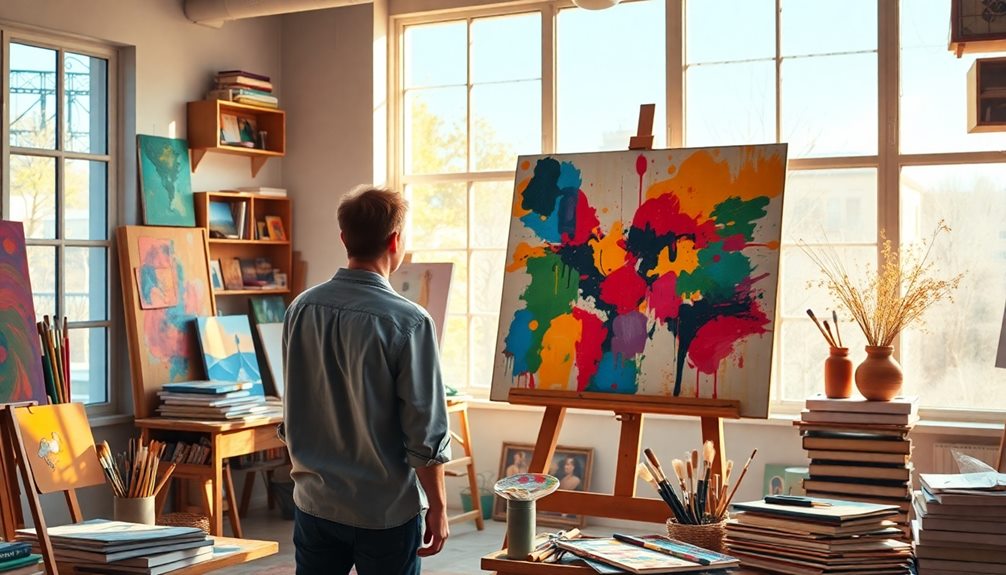To describe artwork effectively, focus on vivid language that captures the viewer's attention. Start with a strong introduction to draw readers in. Highlight key elements like color, texture, and composition while connecting them to the artist's background and historical context. Use emotional language to express your feelings, inviting readers to reflect on their personal connections. Avoid jargon and opt for relatable descriptors that make the art accessible. Lastly, engage your audience with open-ended questions, encouraging their interpretation. By following these steps, you'll add depth to your descriptions and create a richer dialogue about the artwork. There's so much more to uncover!
Key Takeaways
- Begin with a captivating introduction that engages readers and sets the tone for the artwork description.
- Use vivid, descriptive language to convey colors, textures, and shapes, painting a mental image for the reader.
- Incorporate contextual information about the artist and historical significance to enrich understanding and appreciation of the artwork.
- Encourage emotional connections by sharing personal responses and inviting readers to reflect on their interpretations.
- Revise and edit your writing for clarity and precision, ensuring simplicity and relatability in your descriptions.
Introduction

When you're about to describe a piece of artwork, the introduction plays a crucial role in engaging your reader. Start by capturing their attention with a vivid image or intriguing question that invites them into the visual journey. Your introduction should set the stage for the artwork descriptions that follow, making the reader eager to learn more.
Consider the importance of context in interior design, as it can parallel the significance of understanding an artwork's background. Include key elements in your opening, like a brief overview of the artwork's context. Mention the artist's background and historical significance, as this information about the artist enriches the reader's understanding and appreciation. For instance, you might highlight how the artist's experiences shaped the piece or how it fits into a broader artistic movement.
Understanding the role of color palettes in design can also enhance your appreciation of the artwork's tonal choices.
Next, hint at the visual analysis you'll present, focusing on essential aspects like color, texture, size, and shape. This prepares your reader for a more in-depth exploration of the artwork's features.
Key Concepts and Definitions

To effectively describe artwork, it's essential to grasp key concepts and definitions that inform your analysis. An engaging artwork description not only captivates but also guides the viewer through the visual artist's intentions and the emotions behind the piece.
Start by understanding the key elements: a strong introduction, a detailed visual analysis focusing on colors, shapes, and composition, as well as contextual information about the artist and art movement. Exploring how AI systems utilize algorithms to process data and make decisions can also inspire unique perspectives in your descriptions, especially when considering the role of technology in creativity.
Your descriptions should evoke feelings and invite reflection, creating a personal connection with the audience. Use vivid language and specific adjectives to convey the mood—consider terms like "vibrant," "muted," or "contrasting" to articulate the atmosphere of the artwork.
Researching the visual artist's historical background enriches your understanding and enhances your descriptions. This context reveals the significance of the artwork, allowing you to communicate its deeper meaning effectively.
Essential Writing Techniques

Describing artwork effectively requires not just understanding key concepts but also mastering specific writing techniques. First, adopt the K.I.S.S. method—Keep It Simple, Stupid. Use accessible language that avoids complex jargon. Focus on basic descriptors like colors, shapes, and patterns to help readers visualize the art. Engaging with art theory can further enhance your descriptions by providing a deeper context for your analysis.
Next, structure your writing with a captivating introduction that hooks your audience. Lead into a detailed visual analysis that connects emotionally with the artwork. Don't forget to incorporate contextual information about the artist and the piece, such as historical background and art movements. This enriches the reader's understanding and appreciation of the artwork.
Vivid and descriptive language is essential; it paints a mental picture that enhances engagement. However, clarity and precision are vital, so revise and edit your work. Eliminate unnecessary language to maintain focus on the essential elements of the art.
Real-World Artwork Descriptions

Crafting vivid descriptions of real-world artwork captivates your audience and enhances their appreciation. To do this effectively, focus on detailed visual analysis by discussing elements like color, texture, and composition. These details help create a mental image that draws readers into the piece. Use the best words to describe what you see, ensuring your language remains clear and accessible.
Contextual information about the artist, including their background and artistic movements, can enrich understanding and establish significance. When you articulate emotional connections, you invite your audience to reflect on their feelings toward the artwork, fostering deeper engagement.
Incorporate interpretive analysis to explore themes, symbolism, and messages within the piece. This not only invites viewers to consider the narrative but also encourages them to connect on a personal level.
Avoid jargon and opt for simple descriptors to make your descriptions relatable. This approach allows anyone, regardless of their art knowledge, to appreciate the artwork fully.
Tips and Best Practices

When describing artwork, employing vivid and engaging language can significantly enhance your writing. Use the best words to describe art by focusing on colors, shapes, and textures. For instance, instead of saying "the sky is blue," you might say "the cerulean sky envelops the scene, casting a tranquil hue." This imagery helps create a mental picture for your reader.
Incorporate context about the artist and the inspiration behind the piece to enrich understanding. Discuss the historical background, as it can provide layers of meaning that deepen appreciation.
Analyze the composition by exploring how elements are arranged. Describe how the foreground and background interact, influencing the viewer's perception.
Don't shy away from sharing your emotional responses. Art is all about feelings, so express how the piece resonates with you. This personal touch invites readers to connect on a deeper level.
Lastly, remember to revise and edit your work. Strive for clarity and precision; eliminate jargon and unnecessary language to keep your writing engaging and accessible.
These tips and best practices will elevate your artwork descriptions and captivate your audience.
Audience Engagement and Feedback

Engaging your audience in discussions about art not only enriches the conversation but also invites diverse perspectives that can enhance your own understanding.
Encourage your audience to share their personal interpretations and emotions related to the artwork. This fosters a collaborative dialogue, making everyone feel valued and involved.
Utilizing open-ended questions can stimulate critical thinking and invite participation, leading to a richer exploration of themes and techniques within the piece.
By actively seeking feedback from your peers on your artwork descriptions, you can gain valuable insights that help refine your writing and deepen your understanding.
Incorporating audience suggestions and comments into your descriptions creates a sense of community and shared experience, making the art more relatable and accessible.
Regularly sharing your work and inviting constructive criticism not only improves your descriptive skills but also enhances overall appreciation of art within your community.
Audience Interpretation Variability

Artistic expression invites a multitude of interpretations, shaped by each viewer's unique experiences and perspectives. When you look at an artwork, your audience interpretation can differ greatly from someone else's, influenced by personal experiences, cultural backgrounds, and emotional states. This variability leads to a rich tapestry of responses, even when you're all viewing the same piece.
Research shows that factors like age and education level play a significant role in how you perceive visual elements in art. If you share cultural references with the artist or the artwork itself, your understanding and appreciation can deepen. However, if the context is unfamiliar, you might misinterpret the piece entirely.
Additionally, your mood and personality traits can significantly affect how you engage with the artwork. For example, if you're feeling joyful, you might find uplifting themes in a piece that others see as somber.
Acknowledging these differences in audience interpretation can enrich discussions around the artwork, allowing for deeper engagement and a broader understanding of its meaning. Remember, each interpretation adds to the artwork's narrative, creating a more vibrant dialogue about its significance.
Additional Resources

To enhance your ability to describe artwork effectively, tapping into a variety of additional resources can be incredibly beneficial. Start by exploring online platforms like Khan Academy and Coursera, which offer art history courses that deepen your understanding of artistic movements and techniques. This knowledge will empower you when describing a work of art.
Next, utilize art description guides and glossaries available on websites such as Artsy and the Museum of Modern Art (MoMA). These resources can help expand your vocabulary and provide contextual knowledge, making your descriptions more vivid and precise.
Engaging with art communities on social media platforms like Instagram and Pinterest is another great way to observe how other artists and critics describe artwork. You'll gain insights and inspiration that can elevate your own writing.
Don't forget to refer to influential books, like "Ways of Seeing" by John Berger, to enhance your critical thinking about visual culture.
Lastly, attend local gallery exhibitions and workshops, where you can practice describing art in guided discussions and receive valuable feedback from experts. These resources will enrich your skills and confidence in describing a work of art effectively.
Frequently Asked Questions
How Do You Describe Your Art Style in Writing?
You describe your art style by highlighting its defining characteristics. Focus on color, form, and technique, while weaving in influences and themes. Use vivid language to evoke emotions, ensuring readers visualize your unique artistic vision.
What 5 Adjective Words Would You Use to Describe the Artwork?
You might choose vibrant, textured, harmonious, dramatic, and subdued to describe the artwork. Each word captures different aspects, from energy and emotion to surface quality and mood, helping convey the piece's essence effectively.
How Do You Visually Describe Art?
When you visually describe art, focus on colors, shapes, and textures. Use specific adjectives to highlight their qualities, analyze composition and lighting, and consider the artwork's context to deepen your audience's understanding and appreciation.
What Is an Example of an Art Description?
When describing art, you might say, "The vibrant colors dance across the canvas, evoking joy. Textures invite your fingers to explore, while the artist's journey whispers through each brushstroke, sparking your imagination and emotions."
Conclusion
In conclusion, describing artwork effectively combines observation, emotion, and technique. By using vivid language and engaging your audience, you can bring the piece to life in their minds. Remember to consider different interpretations and be open to feedback, as this enriches your writing. With practice and the right approach, you'll not only enhance your own appreciation of art but also invite others to see it through your eyes. Keep exploring and refining your skills!









